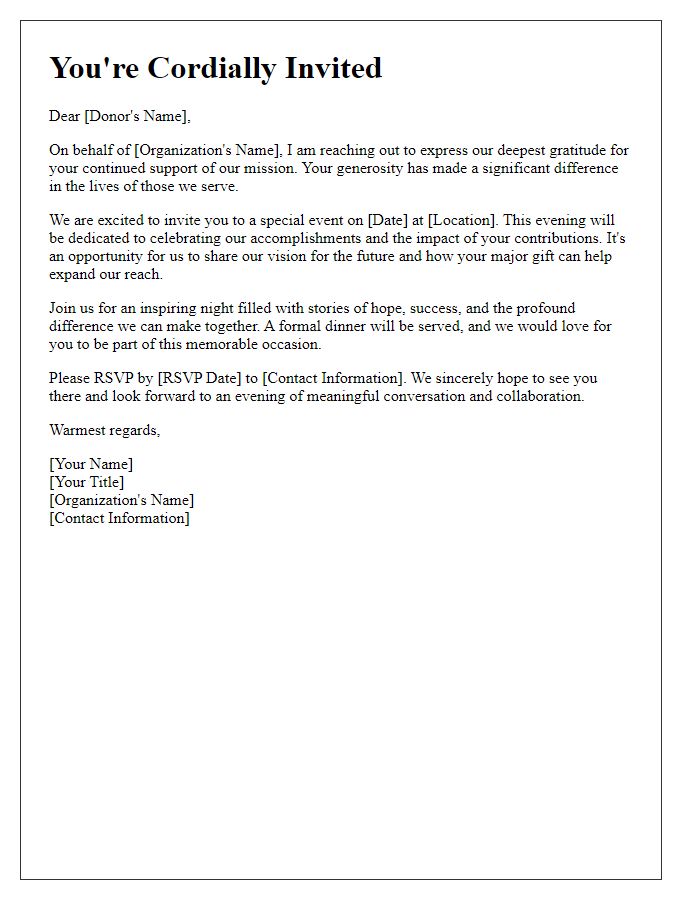Are you ready to make a meaningful impact in our community? In this letter template, we'll explore how to effectively reach out to potential major donors, inviting them to join our mission with their generous support. Crafting your message thoughtfully can turn a simple request into an inspiring call to action. Let's delve into the key elements that will help you create compelling letters that resonate with your audienceâread on to unlock the secrets of successful major gift solicitation!

Donor's Interests and Philanthropic Goals
Identifying potential major gift donors requires an understanding of their interests and philanthropic goals. High-net-worth individuals often focus on specific causes, such as education initiatives, healthcare improvements, or community development projects. Engaging them effectively necessitates research around their previous giving patterns, such as annual donations exceeding $10,000 to particular charities or foundations. Establishing deep connections within their areas of passion, such as local nonprofit organizations in Seattle or national programs supporting mental health, is essential. Tailoring communication to highlight the direct impact of their contributions, like funding scholarships for low-income students or supporting research for innovative medical treatments, can resonate strongly. Emphasizing how their investment can create lasting change and enhance community well-being will align their philanthropic goals with organizational missions.
Impact and Mission Alignment
The impact of significant philanthropic contributions can profoundly advance the mission of nonprofit organizations, such as community development initiatives or educational programs. For instance, a donation of $50,000 can provide scholarships for underserved students in urban areas, enabling access to higher education. This aligns seamlessly with the mission of fostering equitable opportunities and empowering future leaders. Furthermore, by investing in sustainable projects, donors can help create lasting change, such as revitalizing local parks or providing resources for job training programs. Such initiatives not only enhance community resilience but also establish a legacy of social responsibility, making a meaningful difference in the lives of countless individuals and families.
Acknowledgment of Past Contributions
Acknowledging past contributions showcases gratitude and strengthens relationships within nonprofit organizations. Significant donations, such as those contributed by philanthropists over a decade, often surpass hundreds of thousands of dollars. Meaningful impact arises from such generosity, demonstrated through specific projects like community health initiatives or educational scholarships. Recognition of these contributions can enhance donor engagement, reflecting appreciation during special events like annual galas or campaigns. By highlighting successful outcomes, such as increased literacy rates or improved public health metrics, organizations can demonstrate the lasting value of donor support and encourage future giving. Cultivating these relationships can be pivotal in sustaining long-term funding and impactful initiatives.
Clear Call to Action and Donation Process
Major gift solicitations require a compelling and clear call to action, guiding potential donors through the donation process smoothly. A well-structured approach begins with an engaging introduction, often highlighting a specific project or organization mission, such as "The Community Arts Initiative" aiming to enhance local art programs in underfunded neighborhoods. Emphasizing the impact of their contribution can evoke a sense of urgency, citing statistics like "over 60% of local youth lack access to art education." The donation process should be explicitly outlined -- typically including steps to visit a dedicated website, select a donation amount, and choose donation frequency (one-time or recurring). Offering different giving levels, for instance, "Supporter," "Patron," and "Benefactor," along with clearly defined outcomes for each level, can encourage prospective donors to feel their financial involvement matters significantly. Lastly, incorporating heartfelt testimonials from beneficiaries can reinforce the emotional connection and encourage a commitment to giving.
Personalization and Emotional Appeal
Major gift solicitation efforts often focus on developing a personal connection with potential donors, emphasizing shared values and the impact of their contributions. Tailored messaging highlights individual donor stories, showcasing how gifts can create lasting change in specific areas, such as education initiatives or community development projects. Emotional appeals utilize compelling narratives, illustrating the difference that generous donations can make in the lives of individuals or communities impacted by nonprofit work. Utilizing vivid imagery, donors can envision their role in fostering positive transformations, encouraging a sense of belonging to a broader mission. This approach not only enhances personal connection but also drives higher engagement and support for the organization's objectives.













Comments